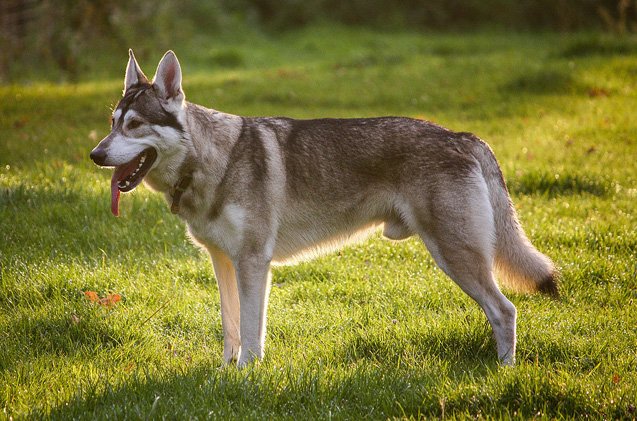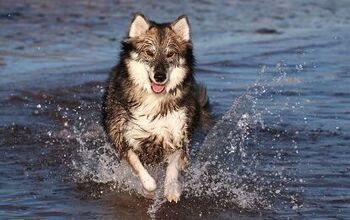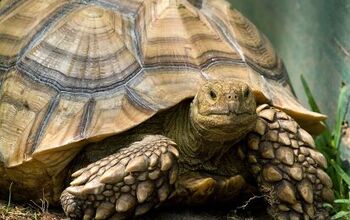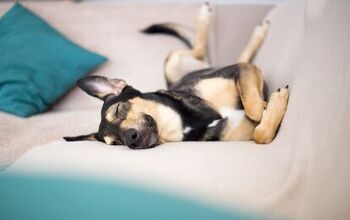Northern Inuit Dog


About Northern Inuit Dog
Some people like tiny dogs that fit in the palm of their hands and feel more like a furry accessory that a pet. Other people want a big dog that makes his presence know. Something as close to a wolf as possible This is one of those dogs. If you were to imagine a large, black and white dog breed that looks almost exactly like a wolf, you may be picturing the Northern Inuit Dog. These large, wolf-like dogs have recently become popular for portraying the Dire Wolf in the HBO ‘Game of Thrones’ series (I’ll bet you can picture it now!). Of course, while their impressive appearance is definitely what first attracts people to the breed, these exotic dogs have so much more to offer than their looks. These aren’t just pretty and majestic animals. There’s so much more to the Nothern Inuit Dog than that.
Despite their wolf-like appearance, these dogs are actually very friendly and unlikely to show aggression. They are far more affectionate than threatening, despite what you may think initially. Intelligent and loyal to their owners, Northern Inuits will make a worthy companion to just about anyone. However, due to the combination of their intelligence and strong will, they can be a bit more difficult to train. This is why these hybrids are a better choice for an experienced owner, as a novice would find them a handful. This should not be the first dog that you ever bring into your life. That would be a mistake.
With its colorful family tree, the Northern Inuit Dog is considered to be a crossbreed. So that means that it’s not recognized by the American Kennel Club. Even so, the breed is gaining popularity rapidly and with good reason. The combination of striking looks and tempered personality leaves no one indifferent. It’s hard not to fall deeply for these dogs, especially if you don’t have to train them yourself! If you are looking for a unique, yet family-friendly dog, you should definitely consider the Northern Inuit Dog. Want to know why? Well then keep on reading. We’re about to reveal everything that you need to know about the dogs that captured the hearts of everyone who watched Game Of Thrones.
These large, wolf-like dogs have recently become popular for portraying the Dire Wolf in the HBO ‘Game of Thrones’ series.
The exact origins of the Northern Inuit Dog are unknown, but there are two stories relating to their history. In one story, the breed was founded by Eddie Harrison who crossbred several mixed-breed rescues with Siberian Huskies, Alaskan Malamutes, and German Shepherds to create the Northern Inuit Dog during the 1980s. In the other story, the Northern Inuit Dog is the product of a cross between Canadian Eskimo Dogs and Labrador Huskies that were brought to the UK from the USA during the late ’70s with Alaskan Malamutes and German Shepherd Dogs. It’s hard to say which one is accurate. There’s a good chance that both stories are true and neither owner knew about the other. It’s tricky to say, but the fact that there are even possible origin stories is more than is known about most hybrid dogs.
Regardless the true origins of the breed, several groups of split to form their own breed groups from the Northern Inuit Society. In the UK there is the British Timber Dog Club, the British Inuit Dog Club and the Inuit Dog Association. These dogs are beloved by their owners and it’s easy to see why.
The Northern Inuit Dog was likely bred from Canadian stock, but it was developed in the UK from various breeds including the Alaskan Malamute and the German Shepherd Dog. As a recent breed that’s still in the process of development, the Northern Inuit Dog is not recognized as an actual breed by official canine clubs. This means that the puppies won’t be registered and there won’t be any papers documenting their ancestry. It’s a shame, but it in a few generations, that is guaranteed to change.
Just like most dogs, the Northern Inuit tends to do best when fed high-quality dry dog food. Kibble is the safest option if you want to be sure you’re meeting your pet’s nutritional needs. Any other type of food (such as raw diet) must be approved by a vet before you give it to your pet.
Keeping in mind that the Northern Inuit Dog is a naturally active breed, you should consider providing him with a dog food formulated for active dogs. You should also make sure that the food is formulated to meet the needs of large-breed dogs. Lastly, their kibble should suit their age. Pick a puppy, adult, or senior blend for different stages of your pet’s life as your animal’s dietary needs will change as they age.
As always, make sure to consult with your vet about your dogs diet. While dog food manufacturers and puppy bloogers provide plenty of valuable information and guidelines, they should still be treated as guidelines and not gospel. Every dog is different after all. The only person qualified to determine the specific dietary needs of your personal pooch is your vet. So, always check in with them before making any substantial changes to your doggie’s diet. It’s why you have a vet, after all. Never be afraid to use them.
Northern Inuit Dogs are highly intelligent so they are capable of responding very well to training.
Northern Inuit Dogs are highly intelligent, so they are capable of responding very well to training. However, you should know that these dogs do have a tendency to become a little stubborn or strong-willed without consistent and firm training. Of course, if you’ve had previous experience with training dogs, this shouldn’t be much of a problem. It only takes a bit more patience than usual! Regardless, these dogs do require a strong leader in the family. Only a confident person who has a firm attitude can successfully train a Northern Inuit Dog. Positive reinforcement methods work wonders, so make sure to rely on treats and praise when rewarding a job well done- rather than using punishment for unwanted behaviors.
Since these dogs are naturally independent and a little more difficult to train than other breeds, they are not the best fit for newbie dog owners. Without proper handling and good relationship with their owner, these dogs could be willful and exhibit various behavior issues. Of course, there are a variety of obedience training schools that could be used to help an inexperienced owner get the results they need. That could certainly help you throughout the process. Yet there’s still nothing like the bonding that emerges from training your own pooch and that’s why Northern Inuit Dogs should primarily belong to experienced owners who will be able to handle all the bumps along the rode. These dogs aren’t for rookies and should be approached cautiously by anyone unprepared for the necessary training commitment.
The average weight for males of this breed is between 80 and 110 pounds while females weigh between 55 and 84 pounds. They are big boys and girls, no doubt about that. And since this can be safely categorized as a large breed, it goes without saying that plenty of free space will be needed. This big breed, originating in nature and its wide landscapes, cannot thrive in confined spaces such as tiny homes or small apartments. Ensure that they have plenty of room and enough opportunity to exercise and enjoy the outdoors.
Of course, this big breed is muscular and athletic, and cannot become chubby or overweight so easily. Still, it is important to offer them only the best and balanced diet. This, in combination with plenty of exercise, will ensure that they remain in their top notch shape. These are true dogs of nature – and their looks are a telltale sign of that!
Despite their wolf-like appearance, the Northern Inuit Dog has a very friendly demeanor and they are unlikely to show aggression. These dogs are very intelligent and quick witted, so they require a strong leader in the family. This breed is not the best choice for inexperienced dog owners, but they do tend to get along well with children. Like all dogs, however, this breed will need supervision when left alone with young children. It is important to note that these dogs require quite a bit of attention. They can develop separation anxiety when left alone too long. For this reason, it is best that Northern Inuit Dogs have another dog in the house as a companion. Otherwise that separation anxiety will lead to problematic behavior.
Overall, the Northern Inuit Dog is a good choice for a companion pet. They are affectionate and loyal, and quite intelligent in the right environment. And sometimes, they can even get a bit spoiled and goofy! All of this makes them fun to be around, no matter for how long. If you are an outdoorsy person who loves hikes and adventures, this breed might be the right choice for you. Northern Inuit Dogs are athletic and belong right in nature! And if you take into account their solid life expectancy of some 14 years, you can see how these dogs can become cherished friends for a very long time.
The Northern Inuit Dog is a healthy breed for the most part, though responsible breeding practices are the only thing that can reduce the risk for congenital conditions. Like all dogs the breed is prone to several minor health issues including cataracts, epilepsy and hip dysplasia. None of these issues are guaranteed, but might happen as they age, making it necessary to maintain regular vet visits as these dogs grow into their senior years. Overall, the Northern Inuit Dog is a very hardy and healthy breed. Their origins lie in the most distant past when dogs first became the companions of humans. And, just as their name suggests, they have always thrived in the inhospitable and wild nature of the extreme north. This gave them some traits that have been carried on through generations. This breed won’t mind a bit of cold and snowfall, just like, for example, the Husky. Still, all the standard precautions and care are mandatory.
The average lifespan of a healthy Northern Inuit Dog is about 12 to 14 years. This is an average life expectancy for most dogs, and usually doesn’t go much above 15 years. It is nevertheless a respectable age, making the Northern Inuit Dog a long-lived and sturdy breed. Of course, you can’t expect nature to take care of everything. These dogs will require your help and care in order to reach their maximum age. Take good care of them by ensuring regular vet visits, a healthy diet, good company, and of course – tons of affection.
The Northern Inuit Dog is a very active breed that requires a significant amount of daily exercise. It is recommended that you provide at least one long walk or jog each day in addition to plenty of playtime. On average, they need about 60 to 90 minutes of activity. So, make sure you’re ready to provide this before you consider getting this breed. Obviously, these are not dogs who thrive in apartment or city living. They need space to roam and exercise in order to become their best selves.
Of course, a great environment for this breed is the outdoors! If you love hiking or camping, this breed might be a great choice for an adventure buddy. They will love the chance to hike out and spend some energy, and get in touch with their origins and nature. Of course, this is a perfect chance to get some exercise! Still, if hiking is not your thing, exercise can be done in the yard, or in the park.
Despite their wolf-life appearance, the Northern Inuit Dog has a very friendly demeanor and they are unlikely to show aggression.
The Northern Inuit Dog is not currently recognized by the American Kennel Club or any of its international counterparts. However, this breed is recognized by the Dog Registry of America and its own independent club, The Northern Inuit Society.
The Northern Inuit Dog has a thick double coat and a straight tail. These dogs often resemble wolves in their black and white coloration, though other colors such as cream or brown are possible. Given the thickness of its coat, this dog will require regular brushing and grooming to control shedding.
Ever since their Game of Thrones debut, Northern Inuit puppies are in high demand. Even so, they remain a fairly rare breed and you can expect to put in a bit of effort before you track down a reputable breeder who has a litter for sale. More often than not, you’ll have to be on a waitlist if you’re serious about becoming a Northern Inuit owner.
Once you get your new puppy home, you should start with the essentials. Socialization is incredibly important for young Northern Inuit Dog puppies and it should begin as soon as they are vaccinated. Keep in mind that play can be very rough while the puppies are young, but it should not be misinterpreted as aggression. Training should start early and kept consistent as the puppy matures to ensure that the dog does not become stubborn or willful.
Photo credit: Malfuros/Wikimedia; ben a.k.a me/Flickr

Amy Tokic, Editor of PetGuide.com, is a passionate animal lover and proud pet parent of Oscar, a Shih Tzu/Chihuahua cross, and Zed, a Japanese Chin. Her love of animals began in kindergarten, when she brought her stuffed dog Snoopy into class with her every day. Now, she writes about her adventures in pet ownership and tirelessly researches products, news and health related issues she can share with other animal enthusiasts. In her free time, Amy loves perusing used book and record stores, obsessing over the latest pet products available and chasing squirrels with wild abandon (a habit attributed to spending too much time with her pooches).
More by Amy Tokic

























